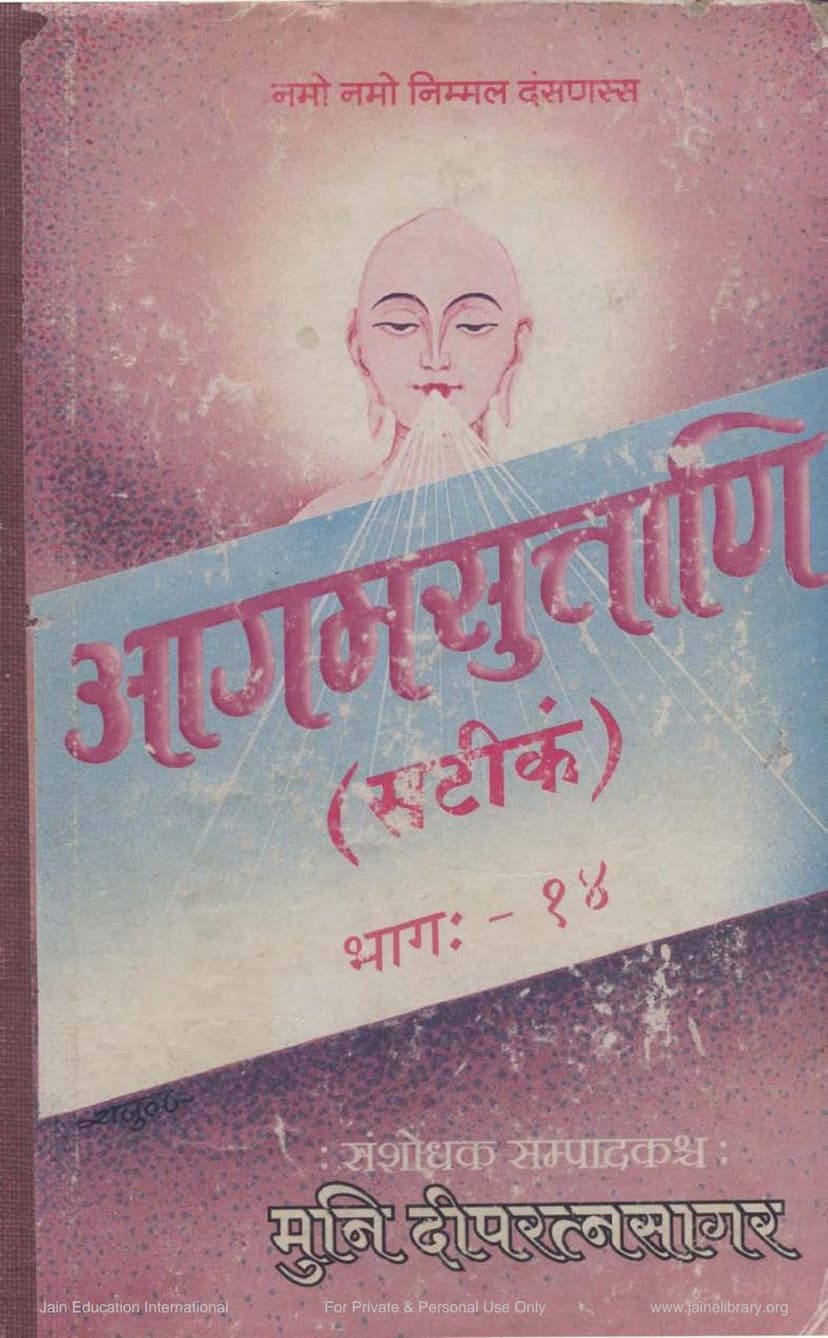Agam Sutra Satik 28 Tandulvaicharika PainngSutra 05
Added to library: September 1, 2025

Summary
Here is a comprehensive summary of the Jain text "Agam Sutra Satik 28 Tandulvaicharika PainngSutra 05":
Book Title: Agam Sutra Satik 28 Tandulvaicharika PainngSutra 05 Author(s): Dipratnasagar, Deepratnasagar Publisher: Agam Shrut Prakashan Catalog Link: https://jainqq.org/explore/003362/1
This text is part of a larger series titled "Agam Suttaani (Satik)," specifically Volume 14. It is a commentary (Satik) on Jain scriptures, with a particular focus on the Tandulvaicharika Prakirnakasutra, which is identified as the fifth Prakirnakasutra. The text is authored by Muni Diperatnasagar and published by Agam Shrut Prakashan.
The volume covers a range of important Jain texts:
- Nirayavalika Upanga Sutra
- Kalpatansika Upanga Sutra
- Pushpika Upanga Sutra
- Pushpachulika Upanga Sutra
- Vrishnidasha Upanga Sutra
- Chatuhsharana Prakirnakasutra
- Mahapratyakhyana Prakirnakasutra
- Tandulvaicharika Prakirnakasutra (the primary focus of this specific summary based on its inclusion and the title)
- Gachchachara Prakirnakasutra
- DevendraStava Prakirnakasutra
- Aaturpratyakhyana Prakirnakasutra
- Bhaktaparigya Prakirnakasutra
- Samstara Prakirnakasutra
- Ganividya Prakirnakasutra
- Maramasamadhi Prakirnakasutra
Summary of the Tandulvaicharika Prakirnakasutra (Book 28):
The Tandulvaicharika Prakirnakasutra, as presented in this volume, delves into detailed descriptions of the human body, life cycles, and the nature of existence, often through numerical and comparative analyses. The commentary provides explanations and interpretations of the original sutras.
Key themes and content discussed in the Tandulvaicharika section include:
- The Nature of Life and Age: It begins by discussing the stages of life, the concept of lifespan, and how it can be divided and understood. The text engages in calculations related to lifespan, possibly in terms of breaths or other units of time.
- Embryonic Development and Birth: A significant portion of the text is dedicated to the process of conception, fetal development within the womb, and the stages of growth from conception to birth. It details the formation of different bodily parts and systems.
- Bodily Composition and Function: The text provides intricate details about the human body's structure, including the number of bones, joints, nerves, veins, and pores. It discusses the functions of various organs and bodily fluids like blood, bile, and phlegm, highlighting their role in health and disease.
- The Impermanence and Impurity of the Body: A recurring and central theme is the transient and impure nature of the physical body. The text graphically describes the body's components as ultimately destined for decay, contamination, and transformation, emphasizing that it is made of impure substances like flesh, blood, and waste products.
- The Cycle of Birth and Death: It touches upon the soul's journey through different life forms and the process of death and rebirth. The text highlights the suffering inherent in the cycle of existence, particularly the pain associated with birth and death.
- The Importance of Dharma: In contrast to the impermanent and impure body, the text strongly advocates for the practice of Dharma (righteous conduct, spiritual discipline) as the true path to liberation and lasting well-being. It stresses that worldly possessions, relationships, and even one's physical body are ultimately transient and cannot provide solace in the face of death.
- The Power of Spiritual Practice: The scriptures emphasize the efficacy of penance, meditation, ethical conduct, and devotion as means to overcome suffering and attain spiritual enlightenment. It contrasts the fleeting pleasures of the material world with the eternal bliss of liberation.
- The Misleading Nature of External Beauty and Worldly Pleasures: The text critiques the attachment to physical beauty and sensual pleasures, portraying them as illusions that distract individuals from their spiritual goals. It describes the body as a vessel of impurity and disease, despite outward appearances.
- The Importance of Righteous Conduct and Knowledge: The scriptures repeatedly underscore the significance of following the teachings of the Tirthankaras, acquiring right knowledge (Samyak Gyana), right faith (Samyak Darshana), and right conduct (Samyak Charitra) as the means to navigate the cycle of existence and achieve moksha.
- The Illusion of Attachment: The text aims to instill detachment from the physical body and worldly affairs by highlighting their inherent imperfections and impermanence. It encourages a focus on the soul's eternal nature and its ultimate destination.
- The Role of Karma: The underlying principle of karma is evident throughout, explaining how actions in this life and past lives influence one's present and future circumstances, including physical attributes and lifespan.
Overall Tone and Purpose:
The Tandulvaicharika Prakirnakasutra, as explained by the commentaries, serves as a powerful tool for developing detachment and aversion towards the physical body and worldly life. By vividly illustrating the biological processes, impurities, and eventual decay of the body, it aims to motivate practitioners towards spiritual pursuits and the ultimate goal of liberation (moksha). The commentary by Muni Diperatnasagar provides detailed explanations, interpretations, and elaborations on these profound concepts, making the ancient wisdom accessible to contemporary readers.